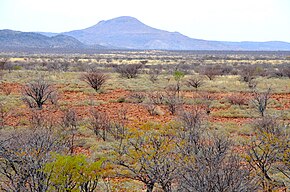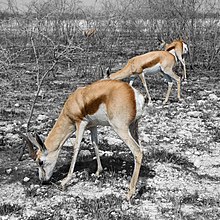Veld



Veld (
Etymology
The word veld (Afrikaans pronunciation:
The etymological origin is older modern Dutch veldt, a spelling that the Dutch abandoned in favour of veld during the 19th century,[2] decades before the first Afrikaans dictionary.[3][4] A cognate to the English field, it was spelt velt[5] in Middle Dutch and felt[6] in Old Dutch.
Climate
The climate of the veld is highly variable, but its general pattern is mild winters from May to September and hot or very hot summers from November to March, with moderate or considerable variations in daily temperatures and abundant sunshine. Precipitation mostly occurs in the summer months in the form of high-energy thunderstorms.
Over most of the South African Highveld, the average annual rainfall is between 500–900 millimetres (20–35 in) a year, decreasing to about 250 millimetres (9.8 in) near the western border and increasing to nearly 1,000 millimetres (39 in) in some parts of the Lesotho Highlands; the South African Lowveld generally receives more precipitation than the Highveld. Temperature is closely related to elevation. In general, the mean July (winter) temperatures range between 7 °C (45 °F) in the Lesotho Highlands and 16 °C (61 °F) in the Lowveld. January (summer) temperatures range between 18 °C (64 °F) and 30 °C (86 °F).
In Zimbabwe the precipitation averages around 750–900 millimetres (30–35 in) on the Highveld, dropping to less than 350 millimetres (14 in) in the lowest areas of the Lowveld. Temperatures are slightly higher than in South Africa.
Over the entire veld, seasonal and annual average rainfall variations of up to 40 percent are common. Damaging drought affects at least half the area about once every three or four years; it reduces plant and animal biomass to sustainable levels again. Everywhere the average number of hours of annual sunshine varies from 60 to 80 percent of the total amount possible.
Definitions
Highveld and Lowveld

Highveld
Much of the interior of
Lowveld
The lowlands, below about 500 m (1,640 ft) altitude, along South Africa's northern border with
Thornveld
Thornveld (also thorn veld or thornveldt), often referred to as "acacia thornveld", is a type of semi-arid savanna in which grassland with thorny acacia and certain species of thorny bushes predominate. The predominant plant species are usually different in the thornveld of the plains or in the hill thornveld, where, for example, species of genus Balanites are common.[14] Some of the characteristic species[15] in the thornveld include:
- Grasses: Grass species belonging to genus Themeda and Hyparrhenia
- Trees and bushes: Genus .
Sandveld and Hardveld


Sandveld
Sandveld, in the general sense of the word, is a type of veld characterised by dry, sandy soil, typical of certain areas of the Southern African region. It usually absorbs all water from the seasonal rains, although aquatic habitats, largely seasonal, may be also found in specific places in the sandveld.
Hardveld
Hardveld is a term applied to certain areas of rocky soils in Botswana, located mostly in the eastern part of the country. The landscape is an undulating plain with scattered rocky hill ranges. There are areas of hardveld also in South Africa in the mountainous central Kamiesberg of the Northern Cape with hilly escarpments and deep river valleys. The soil of the hardveld is characterised by rocky outcrops, as well as an abundance of stones and pebbles of different shapes and sizes.
The flora of the hardveld is typical of rocky
See also
References
- ^ "Southern Africa bushveld". Terrestrial Ecoregions. World Wildlife Fund.
- ^ Winkel, Lammert Allard te. De grondbeginselen der Nederlandsche spelling: Regelen der spelling voor het Woordenboek der Nederlandsche Taal. Publisher: D. Noothoven van Goor, 1873. Download from: [1]
- ^ Eric Anderson Walker (ed). The Cambridge History of the British Empire, Volume 4. Cambridge University Press 1963 (Afrikaans: pp. 890–894)
- ISBN 978-0195337938
- ^ Lemma = "velt", Middelnederlandsch Woordenboek, Dutch Language Union
- ^ Lemma = "felt", Oudnederlands Woordenboek, Dutch Language Union
- ^ Atlas of Southern Africa. (1984). p. 13. Reader's Digest Association, Cape Town
- ISBN 978-0-520-27297-2
- ^ McCarthy t. & Rubidge B. (2005) The Story of Earth & Life. p. 246-247. Struik Publishers, Cape Town.
- ^ McCarthy, T.S. (2013) The Okavango delta and its place in the geomorphological evolution of southern Africa. South African Journal of Geology 116: 1-54.
- ^ Atlas of Southern Africa. (1984). pp. 13, 192, 195. Reader's Digest Association, Cape Town
- ^ Atlas of Southern Africa. (1984). pp. 13, 182, 192. Reader's Digest Association, Cape Town
- PMID 18275594.
- ^ "Thorn Veld Ecozone – Kruger National Park". Ecotravel.co.za. Archived from the original on 11 May 2012. Retrieved 31 October 2012.
- ^ "KwaZulu-Natal Department of Agriculture – Mixed Thornveld Ecozone". Agriculture.kzntl.gov.za. Archived from the original on 1 July 2012. Retrieved 31 October 2012.
- ^ "Aquatic Ecosystems of the Sandveld-Saldanha" (PDF). Archived from the original (PDF) on 20 July 2011. Retrieved 31 October 2012.
- ^ "Thamnochortus bachmannii". PlantZAfrica.com. Retrieved 31 October 2012.
- ^ "Microsoft Word – ORIG_Basin Profile.doc" (PDF). Retrieved 31 October 2012.[permanent dead link]
- ^ "FAO Country Pasture/Forage Resource Profiles – Botswana". Fao.org. Archived from the original on 15 September 2012. Retrieved 31 October 2012.
External links
- Jacobs, Nancy (2000). "Grasslands and Thickets: Bush Encroachment and Herding in the Kalahari Thornveld". Environment and History. 6 (3): 289–316. JSTOR 20723144.
